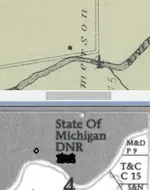Thanks Rook, finding old places along the river isnt as easy as finding home sites on a map, any of you guys have any recommendations to finding fur trade sites?
A forum member found a site......I write that to encourage you.
You're in a region that should relate to a certain area just S.E. of you (depending where in the thumb you are , I really don't want to know for your sake /internet allowing locating your areas of endeavor..) where natives acquired a better lithic material than many other areas.
That is pre fur trade , but does not ignore previous routes.
Waterways and their deltas could be traveled. Food and water.
Vantage points for campsites were not just anywhere , and often used repeatedly.
River forks , creek meets river or similar saw consistent use when travel routes were established.
Spring high water changes things.
I'd be looking for high ground near a waterways junctions in a long running drainage...(travel route running N.S. a long ways for example) where a free trapper could sneak in early.
Natives were willing to travel. Your areas history of forts , and trading posts will relate to eras when they were active.
Era too can affect who it was supplying the goods.
IF for example an alliance was altered , French or English could be the destination for doing some business. Or a tribe in charge of a regions trade.
Who went where (natives going to a fort or major trade hub ,or traders visiting natives, or a native nation in charge of trade being a middleman so to speak...)
Natives traveled. A lot sometimes for varied reasons with warring factions a part of it at times.
Wisconsin to Detroit Mi. around the upper part of the lower penn. through the straits...
And there was a lower E.W. trail around the current MI. Indiana/Ohio border.
As with other ancient trails ,spurs split off and went elsewhere. Often following a drainage or similar geo. feature. More food on a summer river delta and in the river than in the pines or oaks...
Find the trails nearest your hunting site. (Sadly many are paved due to the original good choices of ground and routes.)
Then use a map with good views of river drainage's to study where trail spurs of lesser than major travel could go.
Again higher ground but convenient to water. The vantage point of view/sight would depend on what grew there then , not now.
A forest could exist today where it was open ground then. Though that is likely an extreme example.
Creek meets river , river meets river ect. With a route going beyond it still along a waterway.
IF sniffing off such potential routes , give yourself a reason for cutting cross country first. It happened. But was well reasoned.
IF you can choose an era and figure out who was trading with whom , that's a start.
Then , who camped where , and coming and going from where to where?
An example can be the straits themselves. A huge example with many nations and cultures over the years. Both sides of the water depending on era chosen , with a revolving cast.
Everyone who wintered there came from somewhere originally. Where did they camp in their travels?
Depending on season , and if being pursued or at peace...Camps were chosen for good reason.
A good camp was used again.
An earthwork (really just a pile of soil) banked against a short wall like a palisade stood where two rivers meet a couple hours South of me.
About ten minutes away from me , at another earthwork (mound vs bank) similar enough relics were found that sure fit that place so far South.
N.S. route. Waterways /drainage's. Geo. features. People crossing trails deliberately.
Stuff is deep around me.
Eroded areas below former campsites or spring river flooding shuffles offer more chance of a relic than one on top of the ground.
Yet now and then someone just spies one. Not me though...
There were river valleys around here that saw more permanence than a camp for the night. Camp can mean far more than how much it was used and should probably mean ,why here?
I'm not sure what all went on with the thumb , but on the West side river valleys were certain in winter , but a migration/vacation to the big lake Michigan was a summer event for some/many. What route was taken from Grand Rapids to the big lake? Easy enough to figure/guess looking at a riverine map. Where were camps set up going back and forth? Ahhh. There's a river coming into this one we're following. Where would you camp?
Farther South , pottery making was on a bluff. Why there? Again , fully reasoned.
Farther South a fort. And a lost fort of the same name around there somewhere.
A freetrapper could and did sneak in at ice out through a drainage to an inland winter native camp. So claims the museum.
You know how spring can be.
Add the convenience of trade goods at your lodge after an isolated winter.
Ha! It's you again trapper , on yet another spring. Have not got caught yourself yet?
(The trapper/trader/man of many hats (and few legal ones) spreads a blanket out and dumps his trade stock on it.
You have your winters take of furs. The lady could stand something nice.Her eyes already told you that.
And whats that kettle made of?
You can lighten your load a few furs here and haul less elsewhere. Hmmm.
That's a nice French knife. Don't see them at the Englishman's post on the next river over.)
No , I don't need tobacco , but we can smoke some of yours first....



 GB it’s bad hot here too. RR, I’m guessing you guys are too.
GB it’s bad hot here too. RR, I’m guessing you guys are too.

